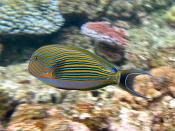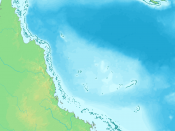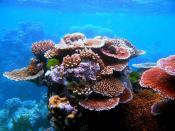The Great Barrier Reef is the world's largest coral reef system, located in the Coral Sea, off the coast of Queensland in northeast Australia. This coral reef system is composed of approximately three thousand individual reefs in addition to nine hundred islands, stretching for 2,600 kilometers and covering an area of approximately 344,400 square kilometers. A huge part of the reef is protected by the Great Barrier Reef Marine Park, which happens to be the world's largest marine park, established in 1975, and covering an area of 345,000 square kilometres (Great Barrier Reef, 2007; Shipping Safety, 2001).
Sometimes referred to as the largest organism in the world, the Great Barrier Reef could be seen from outer space. It is made up of millions of tiny organisms called coral polyps. In the year 1981, this entire coral reef system was selected as a World Heritage Site. The Great Barrier Reef has also been labeled as one of the seven natural wonders of the world by CNN.
And, in Queensland it is referred to as a state icon (Great Barrier).
Undoubtedly, the Great Barrier Reef is a very popular tourist destination for people from within and outside Australia who do not get to see the marvel from outer space. Scuba divers are especially attracted to this tourist destination. Vast biodiversity, warm and clear waters, and the Great Barrier Reef's accessibility from the floating guest facilities known as "live aboards" make it even more appealing. Along the coast of Queensland today, there are many cities that offer boat trips to the great coral reef system on a daily basis. Besides, various continental islands have been turned into resorts to sustain tourism in the area (Great Barrier).
Tourism on the Great Barrier Reef generates around AU$4 billion or more annually with at least...


